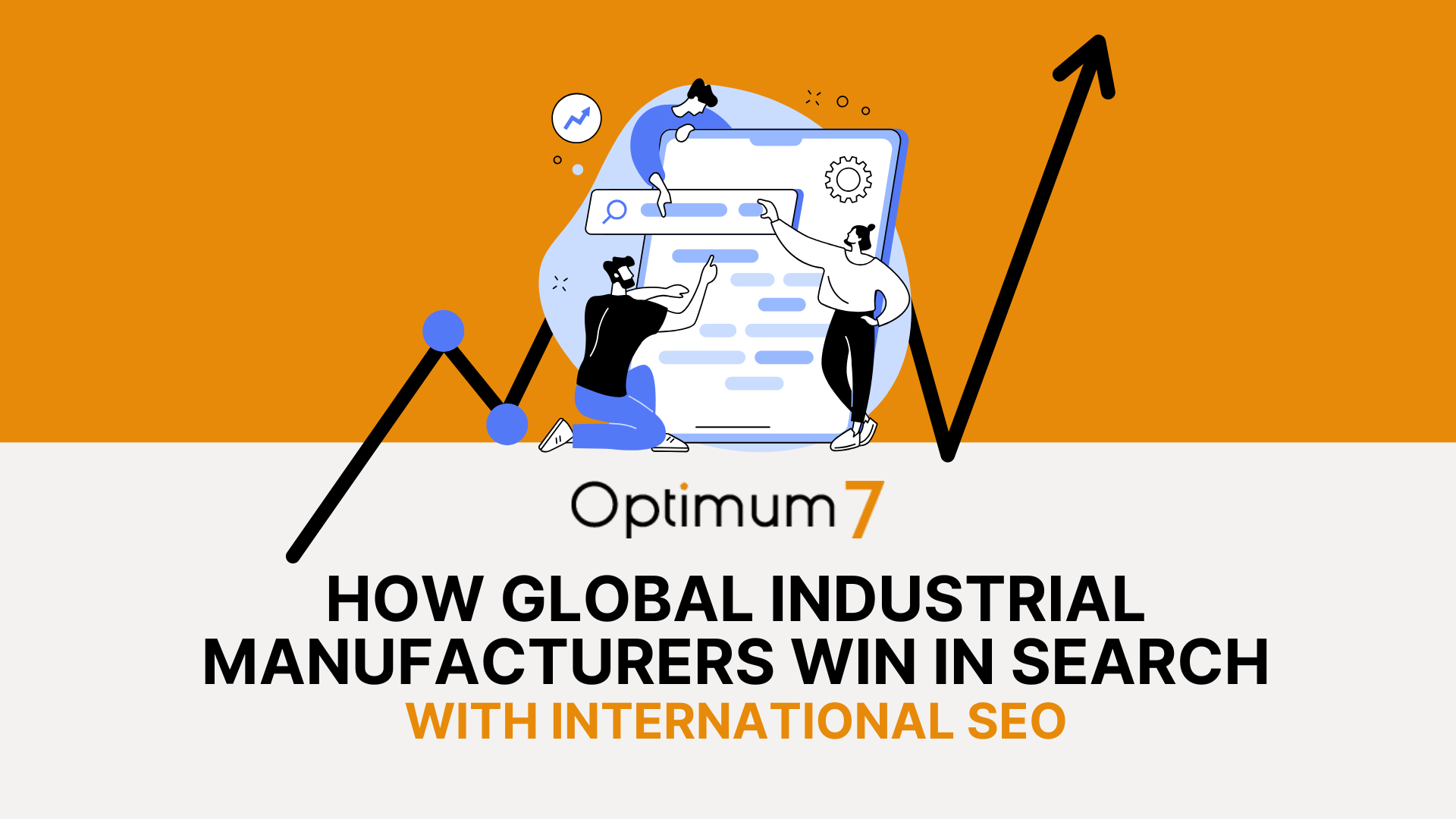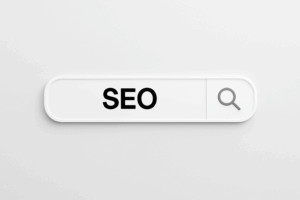Why Global SEO Is Different for Manufacturing Companies
Selling industrial equipment globally isn’t like selling sneakers or electronics. Your buyers are engineers, procurement managers, and plant directors; people who type very specific technical queries into search engines. And the way they search in Chicago isn’t the same as in Shanghai, São Paulo, or Stuttgart.
The challenge is obvious: you can’t just “translate” your website and expect it to work for international B2B SEO. In the industrial space, terminology shifts from country to country. Units of measurement change. Certifications matter. Even the intent behind a search can vary drastically across markets. A phrase that means one thing to an American engineer might mean something completely different to their counterpart in Germany.
Without the right strategy, your multilingual website risks becoming a patchwork of half-optimized pages, pages that don’t rank where they should, don’t get in front of the right audience, and don’t convert the visitors they do manage to attract.
Meanwhile, local competitors who know exactly how to talk to their market, are dominating search results in their own language. They’re winning the clicks, the RFQs, and the brand trust you could be capturing.
This is why international SEO isn’t optional for global industrial manufacturers. It’s the bridge between your global product line and your local buyers. Done right, it ensures that when a potential customer in another country searches for the exact product you make, you are the one they find; who is speaking their language, matching their standards, and earning their trust.
The Global SEO Challenge for Industrial Manufacturers
Global SEO is hard enough for retail brands. But for industrial manufacturers, the challenge is amplified by technical complexity, specialized buyers, and region-specific standards. You’re not just selling a product. You’re selling specifications, compliance, and performance, and all of those mean different things in different markets.
One of the biggest hurdles is terminology. Even within the same language, technical terms shift across regions, something only thorough market research will surface. An “abrasive blasting cabinet” in the U.S. might be called a “sandblasting booth” in the UK and these regional SEO keyword differences do matter. In Germany, it might be searched in relation to DIN standards. If your site only targets one version of that term, you’re invisible to everyone else.
Then there’s search intent. An engineer in Canada searching for “centrifugal pump” might be looking for a specific brand or model number. A buyer in Mexico could be looking for pumps by flow rate or motor type. In the Middle East, the same term might be linked to entirely different performance expectations, driven by environmental factors like temperature or dust exposure. Without localized keyword research, your site is talking past its audience.
Technical indexing is another frequent pain point. Many manufacturers launch multilingual sites but fail to configure hreflang tags properly, creating duplicate content SEO issues and leading Google to serve the wrong version. The result? Your French-language page might show up for someone in Canada who needs an English spec sheet, or your Spanish content might be competing against your own English page in SERPs.
Compliance adds yet another layer. Certifications, safety standards, and even product descriptions must adapt to local regulations. For example, CE marking in Europe or CSA certification in Canada aren’t just checkboxes, they’re local SEO ranking factors. If your content doesn’t reflect those requirements in the local language and context, you’re missing a direct ranking opportunity.
Finally, there’s local competition. In every market, there are domestic manufacturers who understand the language, the culture, and the search habits better than a foreign supplier. They may not match your product quality, but in search, familiarity often wins. Without a proper international SEO strategy, you’re handing them the advantage.
What Happens When International SEO Fails for Manufacturers
When you miss the mark on international SEO, the damage isn’t always loud or dramatic. It’s often silent, and that’s what makes it so dangerous. Every day your competitors are visible in local search results and you’re not; you’re losing opportunities you never even knew existed.
The first and most obvious loss is qualified leads. If your German-language pages don’t show up when a local engineer searches for a DIN-compliant hydraulic press, they’re not going to email you out of curiosity. They’ll find a supplier who is visible, and probably assume you don’t serve their market at all.
Then there are misaligned inquiries. Even when you do appear in search, poorly localized content can send the wrong signals. You end up fielding RFQs for products you don’t offer in that market or answering basic questions about specs that should have been clear from the start. Your sales team wastes time on prospects who were never a fit in the first place.
The brand damage is harder to measure, but it’s real. When local distributors, resellers, or even unauthorized third parties outrank you for your own products in their market, they control the narrative. They decide how your products are presented, and sometimes, they don’t get it right. This can dilute your brand identity and erode trust with serious buyers.
You’ll also feel the cost in your marketing budget. Without organic traffic visibility, many manufacturers lean heavily on paid search to break into international markets. But PPC costs multiply quickly when you’re covering multiple countries and languages. If you’re not ranking organically, you’re losing the compounding benefits that come with SEO.
Finally, there’s the competitive lockout effect. Search engine trust takes time to build, especially in international markets. If you delay your SEO investment, you give local competitors the time to cement their positions in search results. By the time you decide to act, you’re not just trying to climb the rankings, you’re trying to displace entrenched, trusted players.
The bottom line: poor international SEO doesn’t just keep you from growing; it actively hands market share to competitors.
Building a Multilingual, Market-Specific Content Strategy
If the technical framework is the skeleton of your international SEO, the content is the muscle. It’s what gives your site the strength to compete in each market. And for industrial manufacturers, “content” isn’t just blog posts; it’s product descriptions, datasheets, application notes, case studies, and every other touchpoint where you communicate value.
The mistake most companies make is assuming that translation equals localization. They take an English product page, run it through a translator (human or machine), and think the job is done. But translation is just swapping words. Localization is about creating regionally-optimized content that feels written for that market from day one.
That means describing a centrifugal pump in Germany not just in German but with the specs, units, and certifications that a German engineer expects to see. It means reworking a case study for the Brazilian market so it highlights environmental performance in tropical climates, instead of focusing on cold-weather durability that’s irrelevant there. It means rewriting safety guidelines in French to align with European directives, not North American codes.
It also means adapting your technical storytelling. An engineer in India might value a breakdown of energy efficiency over a deep dive into automation features. A procurement manager in the Middle East might be more interested in corrosion resistance due to local climate factors. Your content needs to meet those priorities head-on, in their language, with their standards, and in their cultural context.
This is where a market-specific content calendar becomes powerful. Instead of publishing the same updates everywhere, you create targeted content for each key market, highlighting new certifications, sharing localized installation guides, or publishing success stories from local customers. Every piece reinforces that you’re not just a global brand, but a present and understanding one.
Done right, this strategy has a compounding effect. Each localized page doesn’t just rank better, it builds trust faster. And in industrial sales, trust is the currency that closes deals.
Technical SEO for Global Industrial Sites that Drive International SEO Efforts
Behind every visible search result is an invisible framework of technical details that make it possible for your site to show up in the right place, for the right person, at the right time. For global industrial manufacturers, getting this foundation right is the difference between ranking in your target market and being buried five pages deep.
One of the biggest technical pitfalls is hreflang implementation. These small bits of code tell search engines which language and country a page is meant for. Without them, Google might serve your UK English page to a U.S. buyer – or worse, your English page to a buyer in Japan who needs localized specs. Done correctly, hreflang removes the guesswork and ensures buyers land on the version that actually makes sense for them.
Site structure is another critical choice. Whether you use country-code domains (example.de), subdomains (de.example.com), or subdirectories (example.com/de/) affects both search engine trust and user perception. A country-specific domain often builds credibility in that market but comes with more overhead. A well-organized subdirectory structure can be easier to manage while still sending the right localization signals.
Especially for manufacturers, your URL and navigation design also matter. Clunky or inconsistent URL structures can confuse search engines and users alike. A clean, predictable pattern, paired with a logical hierarch, helps both indexing and user experience, especially for large product catalogs.
Then there’s speed and performance. If you’re serving high-resolution product images and technical PDFs, page load times can slow dramatically for overseas visitors. Optimizing image delivery, using local CDNs, and compressing resources make sure that an engineer in Singapore can view your 3D CAD file as easily as one in Houston.
Multilingual sitemaps tie it all together, giving search engines a roadmap of every localized page you have. This ensures nothing gets lost and every language version is recognized.
Finally, resist the temptation to cut corners with machine translation for technical content. Search engines can detect low-quality translations, and technical buyers will spot mistakes instantly. Accuracy here isn’t just about SEO; it’s about credibility.
When these technical elements are in place, your site becomes more than a collection of pages, it becomes a global, well-structured resource that search engines trust and buyers enjoy using.
How to Build Local Authority for International SEO Success
If you’ve ever tried to sell into a new country, you know the unspoken rule: it’s not just what you sell, it’s who says you’re worth buying from. In your home market, your name might carry weight on its own. Abroad? Not so much. You have to earn it, and Google’s watching for those signs of trust just as much as your buyers are.
The easiest place to start is with the people you already know. If you’ve got distributors in Germany, a service partner in Brazil, or a longtime client in South Korea, make those relationships visible. Feature them on your local pages. Ask for a backlink to your site from theirs. When a respected local business points to you, it tells Google -and potential buyers- “These guys are the real deal.”
It’s the same with local industry directories. In some regions, being listed in the right trade directory or association isn’t just good for SEO, it’s part of being taken seriously. If a plant manager in France is looking for suppliers, and you’re not in the same directory as your competitors, you’re already at a disadvantage.
Then there’s the storytelling angle. Local press releases for new certifications, facility expansions, or big project wins aren’t fluff; they’re proof. When a trade publication in Mexico City runs a piece about how your machinery helped modernize a plant in Monterrey, that’s a signal of relevance that no amount of generic content can match.
And don’t forget the power of speaking the “certification language” of each market. CE marking, CSA approval, ISO compliance, they aren’t just stamps on a spec sheet. They’re keywords buyers search for. They’re trust signals buyers look for. If you’ve earned them, don’t bury them in the fine print. Put them front and center, in the local language.
The truth is, “local authority” is less about playing SEO tricks and more about showing up in the places where your audience already looks for answers. When they see you there (recommended by familiar names, listed in trusted sources, covered in their industry news) you stop being “the foreign manufacturer.” You become a legitimate choice.
Measuring Success in International SEO
One of the hardest parts about achieving international SEO success is knowing if your efforts are actually working. It’s not just about more traffic, you want the right traffic, from the right markets, turning into real opportunities.
The first thing to track when evaluating your international SEO performance is whether you’re actually showing up where you’re targeting. That means looking at search rankings for your localized keywords in each country or region. If you’re selling ball valves in Spain, are you ranking for the Spanish equivalent terms? Are you showing up for the specs and standards buyers actually use? It’s a simple check, but it tells you if your foundation is even in place.
From there, watch inquiries and RFQs by region. It’s not enough to get more clicks, you want to see more qualified contacts coming in from your target markets. If your Canadian traffic has doubled but you’re not getting any new CSA-certified product inquiries, your targeting is off somewhere.
Engagement metrics are another truth-teller. Look at bounce rates, time on page, and pages per session for each localized version. If your German pages have high bounce rates, maybe the translation doesn’t reflect how German engineers search, or maybe your product specs are still in imperial units.
And don’t forget the sales team’s feedback. They’ll tell you quickly if the leads they’re getting from a new market are better qualified than before. Sometimes the real story isn’t in Google Analytics, it’s in the conversations your sales reps are having.
Finally, think long-term. International SEO compounds over time. A bump in rankings this month is good, but the real win is owning those top positions for years, becoming the brand buyers think of first in their market. That’s when the effort starts paying for itself many times over.
International SEO Implementation Toolkit for Industrial Manufacturers
Market & Keyword Localization Framework
| Step | What to Do | Why It Matters |
| Identify target countries & languages | Prioritize by sales potential and distributor presence | Focus resources where ROI is highest |
| Conduct local keyword research | Use native speakers + tools (e.g., SEMrush, Ahrefs, Google Keyword Planner with region filters) | Avoid direct translations that miss search intent |
| Map terminology differences | Document regional technical terms, units, and certifications | Prevent invisibility due to language mismatches |
| Validate buyer intent | Analyze top-ranking content in each market | Align with what engineers/procurement teams expect |
Technical SEO Setup Checklist
Hreflang & Indexing
☐ Correct hreflang implementation for all language-country pairs
☐ Canonicals set to prevent duplicate content conflicts
☐ Country-specific SERP testing to verify correct version is served
Site Structure
☐ Choose domain strategy: ccTLD (.de), subdomain (de.example.com), or subdirectory (example.com/de/)
☐ Keep URL structure clean and predictable
Speed & Access
☐ Deploy CDNs with local nodes for each major region
☐ Optimize PDFs, CAD files, and high-res images for fast load times globally
Sitemaps
☐ Maintain multilingual XML sitemaps submitted to search engines
Market-Specific Content Planning Matrix
| Market | Primary Keywords | Local Standards/Certifications | Content Priorities | Units & Specs |
| Germany | “Sandstrahlkabine DIN” | DIN, CE | Case studies for manufacturing compliance | Metric, °C |
| Brazil | “Bomba centrífuga alta temperatura” | INMETRO | Tropical climate performance | Metric, °C |
| Canada | “CSA centrifugal pump” | CSA | Energy efficiency & compliance | Imperial + Metric |
| Middle East | “Corrosion resistant valve” | ISO, regional | Sand/dust resistance, high-temp durability | Metric, °C |
Local Authority-Building Playbook
| Tactic | Execution Example | SEO Benefit |
| Distributor backlinks | Partner page on German distributor site linking to your German product page | Local link authority |
| Industry directory listings | Listed in UK manufacturing associations | Trust + citation signals |
| Local PR coverage | Press release on Brazilian plant upgrade project | Market relevance |
| Certification visibility | Prominent CE/CSA/ISO badges on local pages | Keyword + trust trigger |
Measurement & Continuous Optimization Dashboard
| KPI | Target | Tracking Method |
| Local keyword rankings | Top 3 for 70% of target terms | Local SERP tools |
| Qualified inquiries per market | +20% YoY | CRM with lead source tracking |
| Bounce rate (localized pages) | <40% | Analytics by language segment |
| Manual translation review score | ≥95% accuracy | Quarterly human QA |
| RFQ-to-close ratio | Uptrend in each region | Sales reports |
This global SEO checklist helps manufacturers align their content and technical SEO for international visibility and regional rankings.
Going Global Means Getting Local
You can’t win global search without winning local search first. No matter how strong your product line is, if your website doesn’t speak the language (literally and technically) of each market, you’re leaving the door wide open for competitors to take business that should be yours.
International SEO for industrial manufacturers isn’t just a marketing tactic. It’s a competitive necessity. It’s how you make sure that when an engineer in Milan searches for a machine that meets European safety standards, your name comes up, not just as an option, but as the obvious choice.
The manufacturers who win in this space aren’t the ones with the biggest budgets or the flashiest websites. They’re the ones who take the time to understand each market, adapt their content and infrastructure, and show up consistently in the places their buyers are already looking.
If your global sales team is fighting uphill battles in certain markets, or if you’re tired of seeing local competitors outrank you for products you invented, it’s time to get serious about your international SEO strategy.
We’ve helped global industrial brands implement international SEO strategies tailored for B2B manufacturing; building systems, content, and authority signals that make them just as competitive in São Paulo or Stuttgart as they are in Chicago. If you want that kind of presence, contact us. We’ll show you exactly where you’re missing opportunities and how to turn your site into a local market leader in every country you serve.
Because in this game, visibility isn’t just about being found; it’s about being found first.










